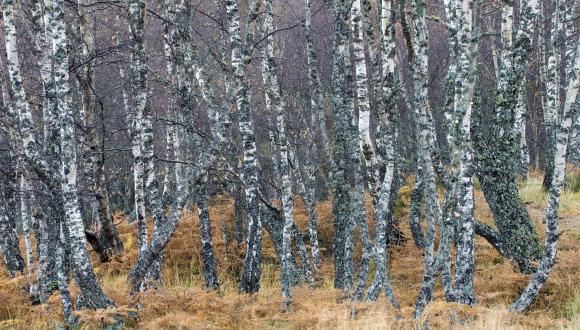
Wood pasture and parkland
Ancient wood pastures are areas of grazed pasture, heath or open hill with a scattering of iconic open-grown veteran trees.
Once a common feature of the Scottish landscape, wood pastures provided shelter, pasture and fodder for livestock and wood products for local people.
This woodland type is still widespread across upland and lowland Scotland, covering an estimated 8,000 to 17,000 hectares in total. Signs of ancient fields or empty crofts can often be found nearby.
Old, open-grown trees are the defining feature of ancient wood pasture. Grazing prevented younger trees from competing, letting some trees survive to a great age. As trees reach old age, growth slows until the crowns start to die back. In wood pasture, with no competing trees, the period of decline can last for many years – centuries in some cases.
Veteran trees often show signs of earlier management. For example, they may have been cut back to a high stump (pollarded) to be kept out of the reach of grazing animals.
Wood pastures are a kind of living ancient monument. This ancient part of our cultural landscape pre-dates the Highland Clearances.
Wood pasture and parkland is a UK Biodiversity Action Plan priority habitat.
Other flora and fauna
The sunlit canopies of the old, open-grown trees attract insects and other wildlife less suited to denser woodland.
Veteran trees feature:
- mosses – growing on large branches and in crevices in the bark
- wood-rotting fungi – which colonise broken branches and stems
- beetles – living in dry dead wood
- sap-sucking flies and hoverflies – in rot-holes, sap runs and other scars
- complex communities of mycorrhizae – these fungi develop in the roots to support a tree’s nutrient uptake
The ageing process provides a continual supply of dead wood in various stages of decay. This long-term ecological continuity is vital to some insects and lichens.
The surrounding pasture and open woodland flowers provide nectar sources for flying insects.
Semi-natural pasture will support:
- grassland fungi
- rare butterflies and moths
- birds such as woodpecker, flycatcher and wryneck
- bats
- stoat and weasel
Explore Scotland’s wood pastures
Visit some of our finest ancient wood pastures in:
- Glen Finglas – this Woodland Trust site has extensive and actively managed ancient upland wood pasture
View breathtaking examples of our ancient parklands:
- Old Oakwood, Dalkeith Country Park
- Cadzow Oakwood, Chatelherault Country Park
Further reading
Wood Pasture: Natural Heritage Management





